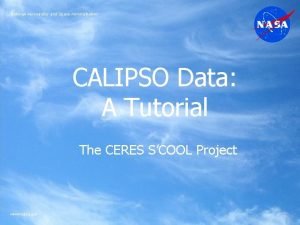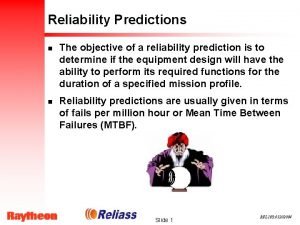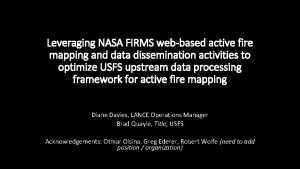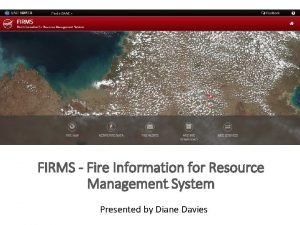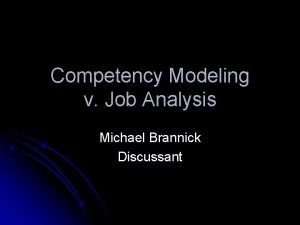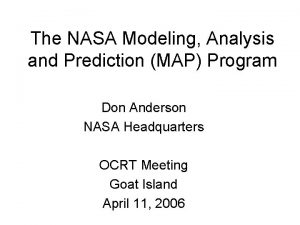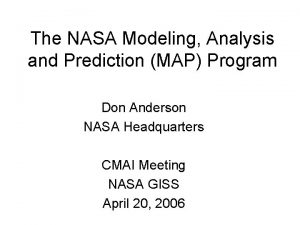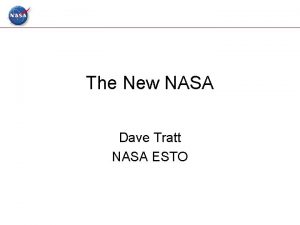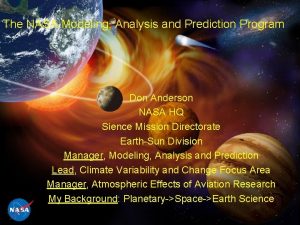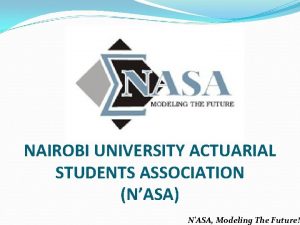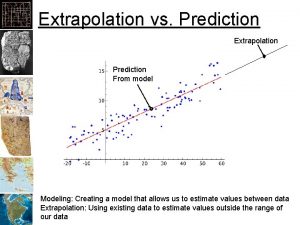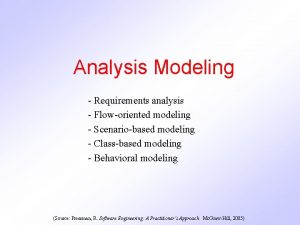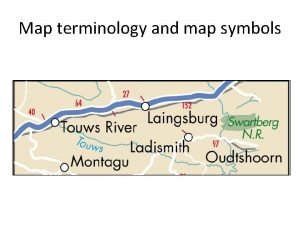The NASA Modeling Analysis and Prediction MAP Modeling











- Slides: 11

The NASA Modeling, Analysis and Prediction (MAP) Modeling Environment Don Anderson NASA HQ Sience Mission Directorate Earth-Sun Division Manager, Modeling, Analysis and Prediction Lead, Climate Variability and Change Focus Area Manager, Atmospheric Effects of Aviation Research


NASA Modeling Paradigm of the Future Frameworks & Integration Environmental modeling and prediction (climate, NWP, . . . ) • Science requires detailed representation of individual physical processes - accuracy, compatibility with observations • Systems integrate diverse components into a comprehensive coupled environmental model Computing technology. . . • Science requires use of scalable computing architectures • Hardware/webservices advances mean that models can run from desktops, even laptops Increase in hardware and software complexity Earth System Modeling Framework Potential to bring together major national modeling centers • ESMF - an environment for assembling geophysical components into applications. • ESMF - a toolkit that components use to i. increase interoperability ii. improve performance portability iii. abstract NASA GEOS 5 common AGCMservices is first model completely implemented with ESMF NASA Software Integration and Visualization Office (SIVO) CAP SURFACE LAND HYDRO VEG DYN ESM LAKE AGCM OCEAN DYNAMICS Ocn CHEM FVCORE SEAICE ATM PHYSICS OGCM GWD GLACIER MOIST RADIATION TURB Atm CHEM SOLAR IR AEROSOL

Where we are going: Modern models integrate components from different sources ESMF accelerates development cycle NASA AGCM for climate and weather GFDL dynamics GMAO physics GMI chemistry GMU ocean GMAO LSM GMAO ocean biology LANL sea ice model Add in the assimilation components and the satellite data science + future mission design

… Program or Branch #N External NRA Proposals Program or Branch #3 Core Integration Team Program or Branch #2 Environment Crosscutting Themes Focus Areas Model, Analysis, Prediction Program / Multi-investigator proposals Program or Branch #1 MAP Modeling ESMF The NASA MAP Modeling Environment Components Added as Program Evolves CMAI GMI ECCO II GISS Model E Modeling 1 Modeling 2 Modeling 3 Modeling N

KATRINA http: //map 05. gsfc. nasa. gov

Overarching Goals - MAP ‘ 05 Project Columbia High End Systems GEOS 4: Existing Model GEOS-4 Sept 24 forecast for rita, ic: Sept 22 • Understand capabilities for NASA models to predict tropical cyclones & other extreme weather events (GEOS 4 & new GEOS 5) • Contribute NASA models to the Florida State University hurricane “Superensemble” to test their impact • Deliver output directly to National Hurricane Center for offline evaluation • Exploit Project Columbia capabilities to deliver model output at unprecedented horizontal resolution (1/4 x 1/4 ) while meeting NOAA operational delivery schedules GEOS 5: Model in Beta Testing

Integrating Multi-Sensor Observations to Improve Models • Leverage international, multi-agency field campaigns (process-focused intensive observing periods) to test, improve model physics • Cross-reference with multi-year, global satellite data sets to understand, improve coupled model performance, simulations of interactive climate processes, document biases • Regional model development and validation of downscaling of global forecasts for regional climate assessment and decision-making Ocean, Land Atmosphere Process studies Long-term in-situ Observation Data Satellite Remote Sensing: TRMM rainfall, CERES surface fluxes, AMSR cloud water / ice, Cloudsat and CALIPSO cloud / aerosol vertical profiles, Quikscat wind stress, AIRS, AMSU, HSB thermal & moisture profiles , MODIS winds, aerosol, clouds, , , Space / time precipitation distribution atmospheric stability Stratiform cloud production Model Problems / Challenges Linkage to National and International Programs… -GCRP GEWEX/CEOP (Land hydrology focus) -WCRP and US CLIVAR (Global oceans and land) Inter Annual Variability & Dynamical Feedback to Climate System Cloud radiative forcing / feedback Conv / ocean evap feedback, surface wind stress CERES - SW anomaly for Jan 1998

The NASA MAP Modeling Environment: Integrating Earth System Modeling and Observations Coupled Earth SYSTEM Modeling and Data Assimilation System for Earth-Sun Science 2006 NASA Modeling Environment 2005 Project Hurricane GEOS-5 JCSDA/GSI fv. GCM (GEOS 4) Project Columbia


NASA Earth Sciences Program Management after Jackie Gasch
 Kahulugan ng awit sa panitikan
Kahulugan ng awit sa panitikan Nasa www.nasa.gov
Nasa www.nasa.gov Helen c. erickson
Helen c. erickson Map prediction
Map prediction Relational vs dimensional data modeling
Relational vs dimensional data modeling Reliability
Reliability Nasa fire map
Nasa fire map Nasa firms fire map
Nasa firms fire map Simulation modeling and analysis law kelton
Simulation modeling and analysis law kelton Process modeling in system analysis and design
Process modeling in system analysis and design Requirements modeling in system analysis and design
Requirements modeling in system analysis and design Job analysis and competency modeling
Job analysis and competency modeling

